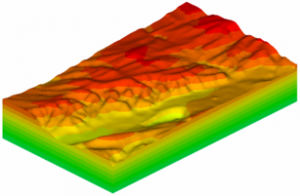- Introduction
The brittle failure and fracturing behaviour of engineering rockmass are the primary forms involved in slabbing, spalling and rockbursts encountered in rock caverns. The corresponding fracturing process is undoubtedly one of the most prominent factors influencing the stability of engineering rockmass. Although many models or theories have been established to describe the plastic deformation of engineering rockmass, an efficient method or tool reflecting the fracturing process is still a topic of interest. Over the past few decades, much effort has been spent investigating numerical methods for the fracturing process of engineering rockmass.
With the rapid development of computing science and system theory, interactive computer graphics and topological applications, the cellular automaton (CA) method with local consideration and parallel characteristics has been proposed to simulate the failure process of heterogeneous rocks. The overall mechanical response of rock is only reflected by the local CA updating rule between the cell and its neighbours. It is more reasonable to reflect the actual fracturing process of heterogeneous rocks. Based on previous work, cellular automata software for the engineering rockmass fracturing process (CASRock) is developed.
New stability analysis indexes, e.g., the rock fracturing degree (RFD) and local energy release rate (LERR), are incorporated into CASRock to evaluate the fracturing degree of engineering rockmass. The application areas include water conservancy and hydropower engineering, coal mining, geological disposal of high-level radioactive waste and CO2 geological sequestration, etc.
CASRock contains a series of previous developed numerical systems, namely EPCA for simulation of heterogeneous rock failure process, VEPCA for visco elastoplastic analysis, D-EPCA for rock dynamic response simulation, THMC-EPCA for coupled thermo-hydro-mechanical- chemical processes in geological media and RDCA2D for simulation of rock cracking process from continuity to discontinuity.
- Renderings


